Sunday, 5 June 2011: From the larger than life to the miniature (with annoying interlude)
Written 11 June 2011
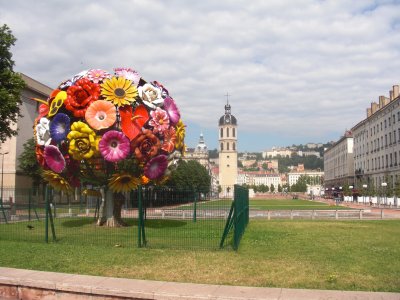
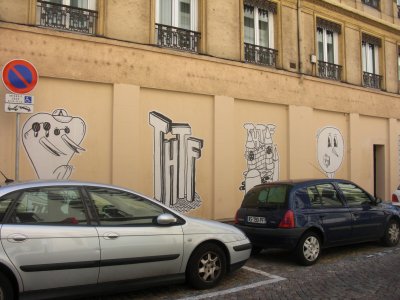 Sorry, some days, I just can't stop snapping the shutter (and on those days, as on this one, I am terribly frustrated by museums that don't allow photos!). This was our last day in Lyon, and we'd saved the Musée des Tissus and its adjoining Musée des Arts Décoratifs for it, because they're open on Sunday. Both are fabulous, especially the former, and neither allows photos! Aaargh!. We took a slightly roundabout route to get there, first to photograph these graffiti, which we'd been walking by all week (they're all over town, all different, most only a foot or so high, and all signed "THTF" (because every single city planter on the long, pedestrian rue Victor Hugo sported at least one, I started to think they were something official, but our Croix Rousse tour guide had no idea and said the letters must just be the artist's signature), and second to walk down a broad esplanade leading from the the Place Bellecour to the banks of the Rhône. It starts with a tower at the Bellecour end (visible in the distance in the right-hand photo), then features a group of strange angular columns with incomprehensible quotations etched on them, then some lawns and flower beds, a nice intermittent fountain (resting momentarily when I took the photo), and finally, on the banks of the river, the "Arbre à fleurs," the "Flower Tree," a work submitted for a temporary exhibition that proved so popular that the city acquired it. The rather ugly fence that surrounds it (to keep people from climbing it) is about chest high. The flowers aren't all different; I saw more than one yellow pansy, more than one red anthurium, etc.
Sorry, some days, I just can't stop snapping the shutter (and on those days, as on this one, I am terribly frustrated by museums that don't allow photos!). This was our last day in Lyon, and we'd saved the Musée des Tissus and its adjoining Musée des Arts Décoratifs for it, because they're open on Sunday. Both are fabulous, especially the former, and neither allows photos! Aaargh!. We took a slightly roundabout route to get there, first to photograph these graffiti, which we'd been walking by all week (they're all over town, all different, most only a foot or so high, and all signed "THTF" (because every single city planter on the long, pedestrian rue Victor Hugo sported at least one, I started to think they were something official, but our Croix Rousse tour guide had no idea and said the letters must just be the artist's signature), and second to walk down a broad esplanade leading from the the Place Bellecour to the banks of the Rhône. It starts with a tower at the Bellecour end (visible in the distance in the right-hand photo), then features a group of strange angular columns with incomprehensible quotations etched on them, then some lawns and flower beds, a nice intermittent fountain (resting momentarily when I took the photo), and finally, on the banks of the river, the "Arbre à fleurs," the "Flower Tree," a work submitted for a temporary exhibition that proved so popular that the city acquired it. The rather ugly fence that surrounds it (to keep people from climbing it) is about chest high. The flowers aren't all different; I saw more than one yellow pansy, more than one red anthurium, etc.
We started with the decorative arts museum, which I described in 1991 as "clocks everywhere!" Yes, it is full of clocks but displays much else as well. Among many other interesting things, I saw (displayed in a convenient circular space surrounded by a grand staircase), a one-person carriage with very high wheels and a velvet seat; a handsome portrait (in uniform) of Louis Malle Marie Hubert Audras (who died 17 April 1918 while serving with the 2nd regiment of dragoons) by Tony Tollet, the namesake of our street (the only reference to him we found anywhere in the city); and a woven raffia case in which you could put away knitting needles with work still on them—a long skinny cylinder closed at both ends but with a slot in the middle. It's a great museum, but if you really want arts décoratifs, try the Louvre and the adjoining Arts Décoratifs in Paris!
The fabric musuem, on the other hand, is without peer and truly knocked our socks off, both this time and back in 1991. The Japanese embroidery alone is worth a visit, but the real knockout section is the weaving. I am just staggered at the fabrics that can be produced on a loom. Each piece is carefully labeled so that those who understand weaving can understand how it was made, and those descriptions are all translated into English, but I still found them incomprehensible, despite knowing some of the terms. One was described, for example as a "Derived figured weft-faced compound twill, 5 lats, brocaded, lozenge foundation even gaufered lozenges, braided: figured web-faced compound tabby; silk, gilded, and silver metal-wrapped threads." Yow. Fred Leysieffer and Ann Redmond are going to have to explain that to me sometime. I was particuarly struck by a fragment of fabric, from Gallo-Roman times, I think, on which the woven fish (mostly trout but of several other species as well) stood out in amazing 3D. You had to walk right up to the piece to prove to yourself that it was really flat.
For the comfort of visitors, the museum provides not just not just the usual padded benches here and there but cushy overstuffed chairs with extra cushions, upholstered in red velvet. At one point, David and I got separated (he was moving through the rooms faster than I was), but when I looked ahead a few rooms looking for him, he was nowhere to be found— no problem; if he wanted me, he'd come get me—so I went back to where I left off and continued my perusal. A few rooms later, I crossed a balcony overlooking the huge two-storey central room where the museum displays carpets, hung on the wall, and there was David, sprawled comfortably in one of the red velvet chairs, his hat over his eyes. Okay, no need to hurry, I guess. I did cut short my viewing of some of the film strips when I noticed that you can access them from home, at http://www. museedestissus.com.
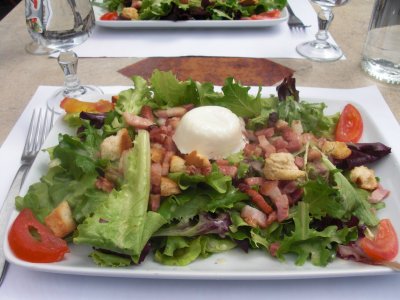
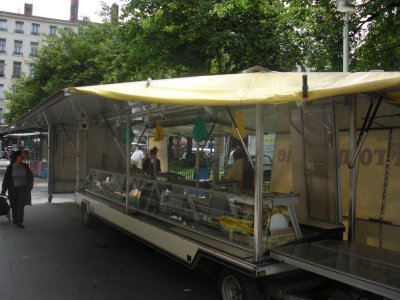 When I finally reached the end of the museum, went back to get David, and after I had dragged him to a couple of the rooms that he just had to see, we went in search of lunch, which we found at the Brasserie Victor Hugo in the Place Carnot, with a view of the Perrache train station. We both had "salade Lyonnaise"—greens, tomatoes, lardons, croutons, soft poached egg. A small market (only a block or so long) was breaking up for the day. With all the food and whatnot put away, it was easier to see how the front and back canopies of this mobile stall fold down to form sides, so that the whole thing can be towed like a narrow trailer to wherever tomorrow's market is.
When I finally reached the end of the museum, went back to get David, and after I had dragged him to a couple of the rooms that he just had to see, we went in search of lunch, which we found at the Brasserie Victor Hugo in the Place Carnot, with a view of the Perrache train station. We both had "salade Lyonnaise"—greens, tomatoes, lardons, croutons, soft poached egg. A small market (only a block or so long) was breaking up for the day. With all the food and whatnot put away, it was easier to see how the front and back canopies of this mobile stall fold down to form sides, so that the whole thing can be towed like a narrow trailer to wherever tomorrow's market is.
At this point, David declared that his feet had had it and that he was going back to the hotel to nap. I was free, if I wished, to carry on—I had mentioned that I wanted to visit the museum of automatons, over on the east bank of the Saône—but he was stopping off when we got to the Résidéal. On the way, we passed the statue of Ampère (no time to visit the museum of electricity) and a bar called "Le Spleen" (it was around the corner from an offal butcher, but I don't know whether the two were connected). David and I parted at the entrance to the lobby. I got about a block away before I realized how much I had missed having the binoculars with me in the museums (I'd forgotten and left them in our room), so I went back to fetch them before going on. I found David at the door of our room, cursing because his electronic key wouldn't open the door! Drat. I tried mine—same problem. The idiots had deactivated our keys a day early! Unfortunately, reception was closed at that time on a Sunday. We searched the lobby and found where they'd posted the emergency number, but of course we had no phone. David camped in the lobby, and I hiked up to the Office de Tourisme, which was open (whew) and where they called the number for me and passed me the phone. Once I convinced the woman who answered that, no, I didn't have a number where she could call me back, I hung on while she called the manager of our Résidéal (Lyon has several) and transferred me to him. He was actually in the building and promised to meet David in the lobby and fix the key. He wasn't willing to wait around for me to get back so that he could fix mine, too, so I walked back, got my binoculars, traded keys with David, and set out again, having lost about 45 minutes.
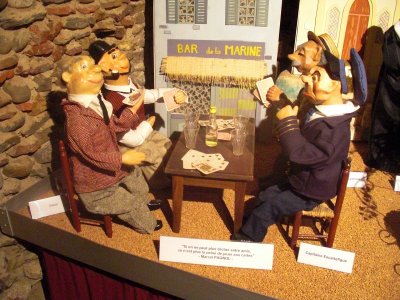
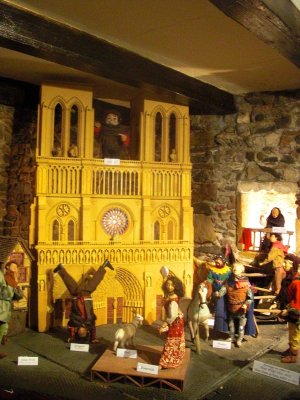 The Musée des Automates turned out to be not such a much. You know those Santa Claus dolls that stand in shop windows and wave one hand up and down all day? That's the kind of automatons we're talking about. Across the street from the museum is the business that makes them, mostly for advertising use. The museum consists of a series of a couple of dozen tableaux populated by automatons that wave a hand up and down, or nod their heads up and down, or bow at the waist and straighten up, or (suspended an inch off the ground) move their feet back and forth to simulate walking. At the left is a representation of the regular game of cards among César and his friends Monsieur Panisse, Capitaine Escartefigue, and Monsieur Lyonnais (from Marcel Pagnol's trilogy of Cesar, Fanny, and Marius). The little caption quotes one of the books, "Si on ne peut plus tricher entre amis, ce n'est plus la peine de jouer aux cartes" ("If you can't cheat among friends anymore, it's no longer worth while to play cards").
The Musée des Automates turned out to be not such a much. You know those Santa Claus dolls that stand in shop windows and wave one hand up and down all day? That's the kind of automatons we're talking about. Across the street from the museum is the business that makes them, mostly for advertising use. The museum consists of a series of a couple of dozen tableaux populated by automatons that wave a hand up and down, or nod their heads up and down, or bow at the waist and straighten up, or (suspended an inch off the ground) move their feet back and forth to simulate walking. At the left is a representation of the regular game of cards among César and his friends Monsieur Panisse, Capitaine Escartefigue, and Monsieur Lyonnais (from Marcel Pagnol's trilogy of Cesar, Fanny, and Marius). The little caption quotes one of the books, "Si on ne peut plus tricher entre amis, ce n'est plus la peine de jouer aux cartes" ("If you can't cheat among friends anymore, it's no longer worth while to play cards").
At the right is a tableau of the characters from Notre Dame de Paris (The Hunchback of Notre Dame). Most of the characters oscillate, but the goat just revolves.
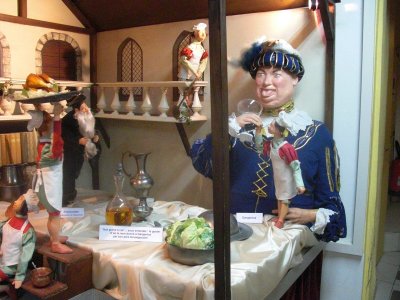 The third photo is of a scene from Rabelais's Gargantua.
The third photo is of a scene from Rabelais's Gargantua.
Other scenes were an orchestra, a circus, the characters from Daudet's Lettres de Mon Moulin, an elaborate scene of several panels from Twenty Thousand Leagues Under the Sea (with a menacing octopus that slides into and out of view through a port hole), Peter Pan (with appearing and disappearing crocodile), characters from Zorro, Pasteur in his laboratory, Jacquard endlessly punching a carton (I wondered, long before I came to it, what that ceaseless thumping was), a canut and his family in their studio/apartment, town life, country life, recreation of a famous painting of two farm workers (not American Gothic), etc., etc.
In a scene of wine making was this little poem (without attribution)
Cherche-tu femme fidèle et douce?
Prends la ficelle pour la Croix-Rousse.
Si tu la veux vive et gentille,
Prends le tramevet de la Guille.
Si tu l'espères sage et pas fière
Grimpe de pied jusqu'à Fourvière!
Mis si tu veux bonheur et paix
Remplis ta cave de beaujolais!
It translates
Do you seek a wife faithful and sweet?
Take the funicular to Croix-Rousse.
If you want her lively and nice,
Take the tram to la Guille.
If you hope she's good and not proud,
Hike to the top of the Fourvière!
But if you want happiness and peace,
Fill you cellar with beaujolais!
But you could look thoroughly at the whole museum in 20 minutes. Ah, well, at least it was free.
I had thought to do the river-cruise company's other itinerary (when our initial 3-day citycards ran out, we bought new, 2-day ones for the remaining two days, and with the new cards came another free river cruise), but I had an hour and a half to spare before the next departure. Great! I would be able to cast a quick look over the Museum of Miniatures and Movie Sets, which was actually between my current location and the cruise location. Again, it would be free with my city card.
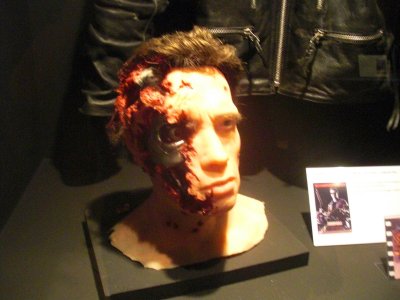
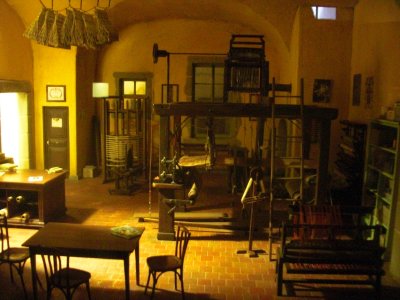 What a difference! This museum is the headquarters of Dan Ohlmann, the miniaturist who made the model of the Lumière mansion. It's in two parts: the museum of film sets and props and the museum of miniatures. The two overlap where miniatures were created for and used in making films, for example for special effects. I spent the whole hour I had and could easily have spent three or four. The museum occupies five floors; you start at the bottom, in the cellar, where you visit the full-size sets from the 2006 movie Perfume: The Story of a Murderer (the actual ones, not replicas; the designers, the same ones who did The Name of the Rose, disassembled them after filming and reconstituted them at the museum). One particularly gruesome set is in a separate room, labeled "not for little kids or the very sensitive." Then, upstairs you pass through room after room of movie props, special effects models, and prosthetics. On the left is a silicone Arnold used in one of the Terminator movies. They also have, e.g., Indiana Jones's hat and whip, the disheveled chickens from OSS 117: Cairo, Nest of Spies, some of the creatures from the gremlins movies, and wonderful displays on the application of prosthetics, like the ape faces from Planet of the Apes and the amazing costume on stilts that allowed a very thin actor (probably actually a dancer or gymnast) to portray some eight-foot mutant werewolf creature. Again, one room with especially gruesome special effects was marked off-limits to children.To the right of Arnold is a1/12-scale model of a canut's studio, by Dan Ohlmann. So if a real chair is 3 feet tall, the model chair is 3 inches tall.
What a difference! This museum is the headquarters of Dan Ohlmann, the miniaturist who made the model of the Lumière mansion. It's in two parts: the museum of film sets and props and the museum of miniatures. The two overlap where miniatures were created for and used in making films, for example for special effects. I spent the whole hour I had and could easily have spent three or four. The museum occupies five floors; you start at the bottom, in the cellar, where you visit the full-size sets from the 2006 movie Perfume: The Story of a Murderer (the actual ones, not replicas; the designers, the same ones who did The Name of the Rose, disassembled them after filming and reconstituted them at the museum). One particularly gruesome set is in a separate room, labeled "not for little kids or the very sensitive." Then, upstairs you pass through room after room of movie props, special effects models, and prosthetics. On the left is a silicone Arnold used in one of the Terminator movies. They also have, e.g., Indiana Jones's hat and whip, the disheveled chickens from OSS 117: Cairo, Nest of Spies, some of the creatures from the gremlins movies, and wonderful displays on the application of prosthetics, like the ape faces from Planet of the Apes and the amazing costume on stilts that allowed a very thin actor (probably actually a dancer or gymnast) to portray some eight-foot mutant werewolf creature. Again, one room with especially gruesome special effects was marked off-limits to children.To the right of Arnold is a1/12-scale model of a canut's studio, by Dan Ohlmann. So if a real chair is 3 feet tall, the model chair is 3 inches tall.
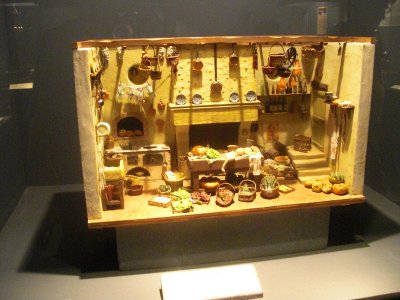
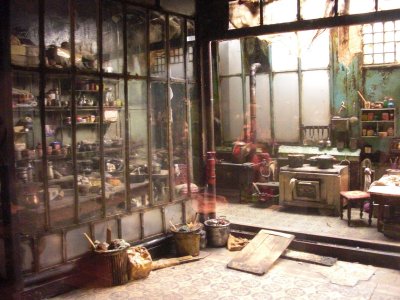 On the top couple of floors are the miniatures that are just works of art, and they are breathtaking. Some are by Ohlmann himself, others by other miniaturists, amateur or professional. Many take the form of whole scenes or rooms. To see what sets Ohlmann's work apart, compare these two photos. On the left is a "country kitchen" by some other miniaturist. It's lovingly crafted and contains amazingly beautiful miniatures of everthing a country kitchen should contain, and it's all laid out for display to the viewer. On the right is Ohlmann's 1/12 replica of a real kitchen. Even viewing the full-size photo, blown up for close examination, I had to double-check to make sure I hadn't mixed it up with a photo of a full-scale movie set. But yes, that square stool is probably an inch tall, and all those cans and bottles on the shelves considerably less. From an ajacent viewing window, you can look into the pantry area, here partially obscured by the glass partition.
On the top couple of floors are the miniatures that are just works of art, and they are breathtaking. Some are by Ohlmann himself, others by other miniaturists, amateur or professional. Many take the form of whole scenes or rooms. To see what sets Ohlmann's work apart, compare these two photos. On the left is a "country kitchen" by some other miniaturist. It's lovingly crafted and contains amazingly beautiful miniatures of everthing a country kitchen should contain, and it's all laid out for display to the viewer. On the right is Ohlmann's 1/12 replica of a real kitchen. Even viewing the full-size photo, blown up for close examination, I had to double-check to make sure I hadn't mixed it up with a photo of a full-scale movie set. But yes, that square stool is probably an inch tall, and all those cans and bottles on the shelves considerably less. From an ajacent viewing window, you can look into the pantry area, here partially obscured by the glass partition.
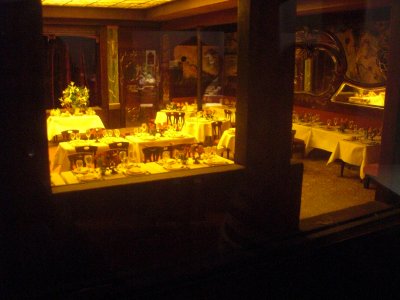
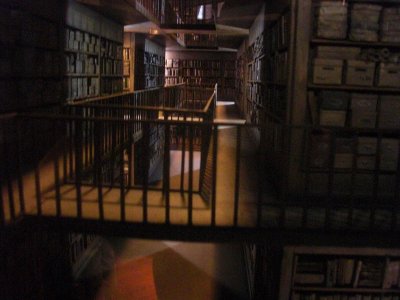 On the left here is a replica of Maxim's in Paris. On the right, a multistory library and archive. Both to 1/12 scale. Think about how tall a real wine glass is, or a book or file box, then divide by 12. On the top floor, in Ohlmann's glass-walled workshop, a replica of the interior of Brasserie Georges is in process of construction.
On the left here is a replica of Maxim's in Paris. On the right, a multistory library and archive. Both to 1/12 scale. Think about how tall a real wine glass is, or a book or file box, then divide by 12. On the top floor, in Ohlmann's glass-walled workshop, a replica of the interior of Brasserie Georges is in process of construction.
In addition to these complete scenes, the museum displays hundreds of individual pieces: tiny cakes, pies, bowls of fruit salad, baskets of whole fruit, etc. made of blown glass; one-inch pizzas in their tiny cardboard boxes; 1/12-scale chippendale chairs and inlaid chests of drawers; miniature farm implements and carpenter's tools. Some displays include strategically placed magnifying glasses, so that you can appreciate the fine detail. You could spend hours. One whole room is devoted to paper cuts, like those Lucretia Beerli-Bieler makes, only smaller. One, about the size of a large postage stamp, was of a flowering branch with a spider's web, all cut out of black paper. The place is just amazing. For more information, and way better photos than I could take, visit its website, at http://www.mimlyon.com/
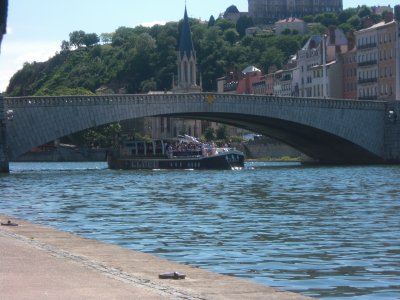
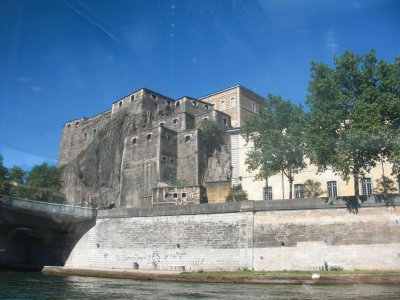 Walked over the Passerelle du Palais de Justice (encountering on the way a guy sitting on the sidewalk playing steel-band tunes on a single, flying-saucer-shaped hollow metal device) and got the cruise company's mooring just on time and secured a ticket for the cruise up the Saône, around the Île Barbe (Barbe Island) and back again. Just before our boat, this time Elle, arrived to pick us up, we started hearing the sounds of a thumping base line and dance music, and it seemed to be getting closer. I consulted the locals in the crowd, and no one seemed to know of any occasion for a parade, unless, someone said, it's to do with the "nuits sonore," a series of afternoon and evening free musical events. The music continued to approach, and finally its source emerged—a barge called Volupté (Voluptuousness, shown here emerging from under a bridge) that we had seen moored on the Rhône during our last cruise, was coming up the Saône with a party aboard. Wall-to-wall young people, both inside the cabin and outside on the deck, were gyrating happily in time to the pounding beat. While Elle pulled up to the quai to unload the previous passengers, the barge continued past us by a bridge or two, then turned around, came back, and pulled in behind us at the quai so that a couple of people could get off to talk to our captain. I was afraid they would follow us upstream, eliminating any faint chance I might have of spotting wildlife, but they then continued downstream. Elle then had to wait a few minutes for a river tug to push a huge cargo barge (perhaps six times the size of the Volupté) past us, and to wait for its wake to settle, before setting out.
Walked over the Passerelle du Palais de Justice (encountering on the way a guy sitting on the sidewalk playing steel-band tunes on a single, flying-saucer-shaped hollow metal device) and got the cruise company's mooring just on time and secured a ticket for the cruise up the Saône, around the Île Barbe (Barbe Island) and back again. Just before our boat, this time Elle, arrived to pick us up, we started hearing the sounds of a thumping base line and dance music, and it seemed to be getting closer. I consulted the locals in the crowd, and no one seemed to know of any occasion for a parade, unless, someone said, it's to do with the "nuits sonore," a series of afternoon and evening free musical events. The music continued to approach, and finally its source emerged—a barge called Volupté (Voluptuousness, shown here emerging from under a bridge) that we had seen moored on the Rhône during our last cruise, was coming up the Saône with a party aboard. Wall-to-wall young people, both inside the cabin and outside on the deck, were gyrating happily in time to the pounding beat. While Elle pulled up to the quai to unload the previous passengers, the barge continued past us by a bridge or two, then turned around, came back, and pulled in behind us at the quai so that a couple of people could get off to talk to our captain. I was afraid they would follow us upstream, eliminating any faint chance I might have of spotting wildlife, but they then continued downstream. Elle then had to wait a few minutes for a river tug to push a huge cargo barge (perhaps six times the size of the Volupté) past us, and to wait for its wake to settle, before setting out.
Not much in the way of wildlife, even though the island was billed as "an island of greenery in the middle of the city." It was, in fact, heavily wooded but was divided into a half-dozen private properties, each with a large house. Historically, it was occupied by an abbey, but only one tower and some ruins survive of that. I did spot a large, dark-colored bird of prey, with a slightly forked tail. My first hypothesis is always "buse," the most common such bird in France, but according to Google images the tail of the buse is rounded. [Note added later, after consultation, back in Tallahassee, of my guide to birds of Europe: It was a "milan noir," a black kite, and I subsequently saw many of them on our travels around the area. They like to hang around water.] Some of the mallards had half-grown ducklings. Among other things pointed out by the guide were a grotto with a statue of a 19th-century inhabitant of Lyon, of German origin, who pledged a particulary large sum to help the victims of some epidemic or other and was thereafter known as the "good German," and the imposing stone edifice shown on the right above, which used to defend the river approach to the city but now houses the department of public works or some such.
Something mentioned frequently by every guide we've talked to, and which we've seen comemorated all over town in the form of plaques marking high water, is the frequency with which the Saône and Rhône used to flood the city. Both are now securely embanked on both sides and, as is frequently said with relief by not-very-old people who can still remember when they weren't, floods are a thing of a past. The island, though, is not embanked, so the residents presumably periodically find their houses under water, in the literal, nonfinancial sense. We also didn't see embankments in the towns downstream later in the trip, so maybe the floods that no longer happen in Lyon are just shoved downstream . . .
The guide also explained the strange metal spire up on Fourvière. It's a privately constructed replica of the top level of the Eiffel Tower, originally intended to house a restaurant and to serve as a tourist attraction but now serving as a TV relay tower.
Finally, on both this cruise and the first one, the guide explained the origin of the term "bâteaux mouches," "fly boats." That's what the tour boats on the Seine in Paris are called, and we'd never heard a plausible reason why. Well, it seems that the first person to get permission to operate boats for the transport of passengers on the river in Lyon had several specially designed boats built for the purpose, in a district of Lyon called "Les Mouches" ("The Flies"). Those boats were therefore called "bâteaux mouches," and the term was extended to passenger-carrying river boats in general.
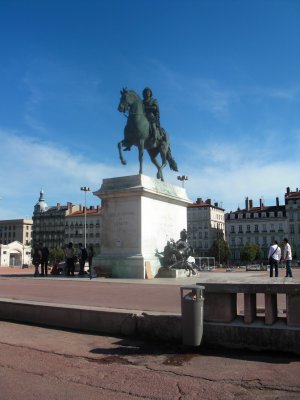
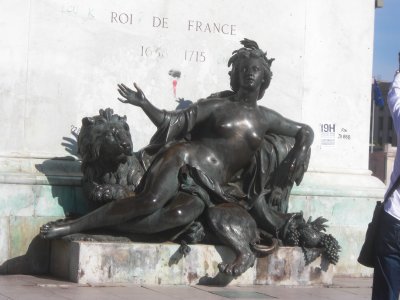 Walking back across the Place Bellecour, I finally paused to get photos of the large equestrial statue of Louis XIV (replaced after it was pulled down during the revolution) and the personification of the Saône on the near side of its pedestal (the original; apparently not an offense to the revolutionaries). A male figure represents the Rhône on the other side.
Walking back across the Place Bellecour, I finally paused to get photos of the large equestrial statue of Louis XIV (replaced after it was pulled down during the revolution) and the personification of the Saône on the near side of its pedestal (the original; apparently not an offense to the revolutionaries). A male figure represents the Rhône on the other side.
Once I'd gotten back to the room, taken both keys downstairs (where reception was now open) to be programmed, and rested my feet a few minutes, it was time to think about dinner! We dined at Le Nord (The North), one of five brasseries in Lyon under the aegis of Paul Bocuse, four of which are named for the points of the compass and serve food appropriate to their names. Le Nord is the only one to make it into the GM Guide, at a score of 13.
David ordered the "Sunday menu," but I ordered à la carte because I wanted the andouillettes "tiré à la ficelle."
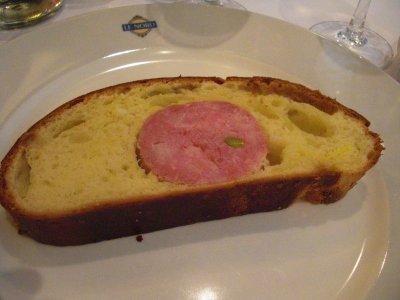
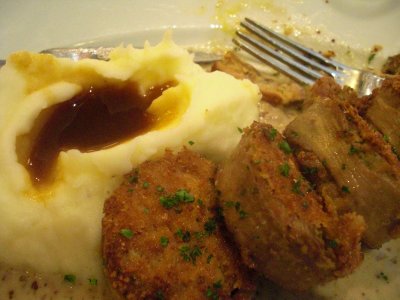 First course: We both started with pistachio-studded sausage baked in brioche, served warm. My à la carte slice, shown here, was somewhat thicker than David's menu slice. A very fancy way, indeed, to make a hotdog, and very good.
First course: We both started with pistachio-studded sausage baked in brioche, served warm. My à la carte slice, shown here, was somewhat thicker than David's menu slice. A very fancy way, indeed, to make a hotdog, and very good.
Second course, David: Roast lamb with scalloped potatoes.
Second course, me (right): Andouillettes "tiré à la ficelle" with mashed potatoes. The andouillettes were, indeed "tiré à la ficelle" and, as is usual, were sliced and sautéed on the cut sides (rather than servedin their intact sausage shape, like ordinary andouillettes, but they were smaller in diameter than those I've see on other tables this week and were not the concentric slices I expected. The contents had been "pulled with a string," intact, through the casing rather than chopped, but in parallel rather than concentrically. Good, but a little acid for my taste, and the mustard sauce was really vinegary. A small salad was served on the side.
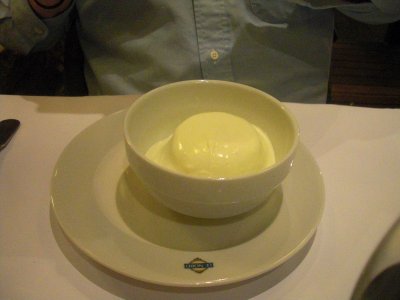
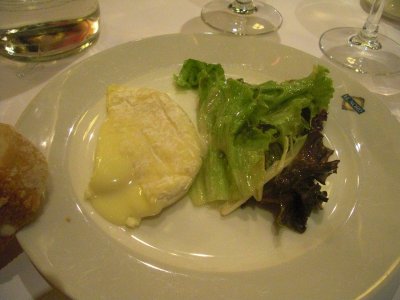 Cheese, David: Faisselle de fromage blanc à la crême. In this area, this option is offered with every cheese course, whereas elsewhere it's relatively infrequent. David has been opting for it often. The fromage blanc is drained in a cylindrical sieve, a "faisselle," until it's just firm enough to hold its shape, then served with cream. With sugar or fruit it can be a dessert; with salt and/or fresh herbs, it's usually a cheese course (around here, they add chopped raw garlic to the fresh herbs, and I saw one lady salt hers then cover it with a thick sprinkling of ground black pepper).
Cheese, David: Faisselle de fromage blanc à la crême. In this area, this option is offered with every cheese course, whereas elsewhere it's relatively infrequent. David has been opting for it often. The fromage blanc is drained in a cylindrical sieve, a "faisselle," until it's just firm enough to hold its shape, then served with cream. With sugar or fruit it can be a dessert; with salt and/or fresh herbs, it's usually a cheese course (around here, they add chopped raw garlic to the fresh herbs, and I saw one lady salt hers then cover it with a thick sprinkling of ground black pepper).
Cheese, me: Half a ripened Saint Marcellin (the consensus serving size around here, if it's the only cheese you get). You can see that as soon as it was released from its rind, it started making a break for the edge of the plate, proteolysed to liquidity. It was excellent!
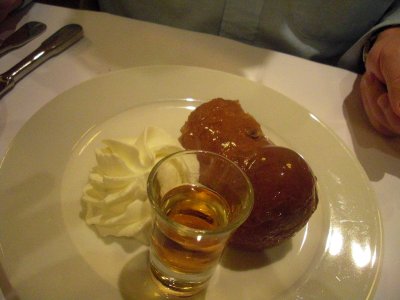
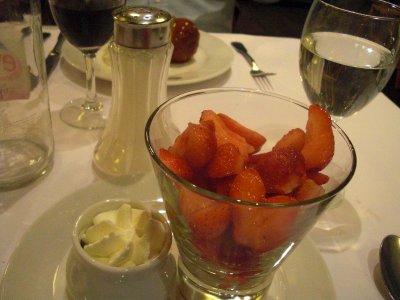 Dessert, David: Classic baba au rhum. This time, the baba was, as always, soaked in rum syrup, but the glass of pure rum was served on the side so that the diner could add as much or as little as he wanted. David went easy.
Dessert, David: Classic baba au rhum. This time, the baba was, as always, soaked in rum syrup, but the glass of pure rum was served on the side so that the diner could add as much or as little as he wanted. David went easy.
Dessert, me: Strawberries, cream and sugar on the side. They were great! Wonderfully tender and juicy and, with a little sugar, perfectly sweet. Yum.
A great ending to our series of Lyon dinners.
previous entry
List of Entries
next entry

 Sorry, some days, I just can't stop snapping the shutter (and on those days, as on this one, I am terribly frustrated by museums that don't allow photos!). This was our last day in Lyon, and we'd saved the Musée des Tissus and its adjoining Musée des Arts Décoratifs for it, because they're open on Sunday. Both are fabulous, especially the former, and neither allows photos! Aaargh!. We took a slightly roundabout route to get there, first to photograph these graffiti, which we'd been walking by all week (they're all over town, all different, most only a foot or so high, and all signed "THTF" (because every single city planter on the long, pedestrian rue Victor Hugo sported at least one, I started to think they were something official, but our Croix Rousse tour guide had no idea and said the letters must just be the artist's signature), and second to walk down a broad esplanade leading from the the Place Bellecour to the banks of the Rhône. It starts with a tower at the Bellecour end (visible in the distance in the right-hand photo), then features a group of strange angular columns with incomprehensible quotations etched on them, then some lawns and flower beds, a nice intermittent fountain (resting momentarily when I took the photo), and finally, on the banks of the river, the "Arbre à fleurs," the "Flower Tree," a work submitted for a temporary exhibition that proved so popular that the city acquired it. The rather ugly fence that surrounds it (to keep people from climbing it) is about chest high. The flowers aren't all different; I saw more than one yellow pansy, more than one red anthurium, etc.
Sorry, some days, I just can't stop snapping the shutter (and on those days, as on this one, I am terribly frustrated by museums that don't allow photos!). This was our last day in Lyon, and we'd saved the Musée des Tissus and its adjoining Musée des Arts Décoratifs for it, because they're open on Sunday. Both are fabulous, especially the former, and neither allows photos! Aaargh!. We took a slightly roundabout route to get there, first to photograph these graffiti, which we'd been walking by all week (they're all over town, all different, most only a foot or so high, and all signed "THTF" (because every single city planter on the long, pedestrian rue Victor Hugo sported at least one, I started to think they were something official, but our Croix Rousse tour guide had no idea and said the letters must just be the artist's signature), and second to walk down a broad esplanade leading from the the Place Bellecour to the banks of the Rhône. It starts with a tower at the Bellecour end (visible in the distance in the right-hand photo), then features a group of strange angular columns with incomprehensible quotations etched on them, then some lawns and flower beds, a nice intermittent fountain (resting momentarily when I took the photo), and finally, on the banks of the river, the "Arbre à fleurs," the "Flower Tree," a work submitted for a temporary exhibition that proved so popular that the city acquired it. The rather ugly fence that surrounds it (to keep people from climbing it) is about chest high. The flowers aren't all different; I saw more than one yellow pansy, more than one red anthurium, etc.
 When I finally reached the end of the museum, went back to get David, and after I had dragged him to a couple of the rooms that he just had to see, we went in search of lunch, which we found at the Brasserie Victor Hugo in the Place Carnot, with a view of the Perrache train station. We both had "salade Lyonnaise"—greens, tomatoes, lardons, croutons, soft poached egg. A small market (only a block or so long) was breaking up for the day. With all the food and whatnot put away, it was easier to see how the front and back canopies of this mobile stall fold down to form sides, so that the whole thing can be towed like a narrow trailer to wherever tomorrow's market is.
When I finally reached the end of the museum, went back to get David, and after I had dragged him to a couple of the rooms that he just had to see, we went in search of lunch, which we found at the Brasserie Victor Hugo in the Place Carnot, with a view of the Perrache train station. We both had "salade Lyonnaise"—greens, tomatoes, lardons, croutons, soft poached egg. A small market (only a block or so long) was breaking up for the day. With all the food and whatnot put away, it was easier to see how the front and back canopies of this mobile stall fold down to form sides, so that the whole thing can be towed like a narrow trailer to wherever tomorrow's market is.
 The Musée des Automates turned out to be not such a much. You know those Santa Claus dolls that stand in shop windows and wave one hand up and down all day? That's the kind of automatons we're talking about. Across the street from the museum is the business that makes them, mostly for advertising use. The museum consists of a series of a couple of dozen tableaux populated by automatons that wave a hand up and down, or nod their heads up and down, or bow at the waist and straighten up, or (suspended an inch off the ground) move their feet back and forth to simulate walking. At the left is a representation of the regular game of cards among César and his friends Monsieur Panisse, Capitaine Escartefigue, and Monsieur Lyonnais (from Marcel Pagnol's trilogy of Cesar, Fanny, and Marius). The little caption quotes one of the books, "Si on ne peut plus tricher entre amis, ce n'est plus la peine de jouer aux cartes" ("If you can't cheat among friends anymore, it's no longer worth while to play cards").
The Musée des Automates turned out to be not such a much. You know those Santa Claus dolls that stand in shop windows and wave one hand up and down all day? That's the kind of automatons we're talking about. Across the street from the museum is the business that makes them, mostly for advertising use. The museum consists of a series of a couple of dozen tableaux populated by automatons that wave a hand up and down, or nod their heads up and down, or bow at the waist and straighten up, or (suspended an inch off the ground) move their feet back and forth to simulate walking. At the left is a representation of the regular game of cards among César and his friends Monsieur Panisse, Capitaine Escartefigue, and Monsieur Lyonnais (from Marcel Pagnol's trilogy of Cesar, Fanny, and Marius). The little caption quotes one of the books, "Si on ne peut plus tricher entre amis, ce n'est plus la peine de jouer aux cartes" ("If you can't cheat among friends anymore, it's no longer worth while to play cards"). The third photo is of a scene from Rabelais's Gargantua.
The third photo is of a scene from Rabelais's Gargantua. 
 What a difference! This museum is the headquarters of Dan Ohlmann, the miniaturist who made the model of the Lumière mansion. It's in two parts: the museum of film sets and props and the museum of miniatures. The two overlap where miniatures were created for and used in making films, for example for special effects. I spent the whole hour I had and could easily have spent three or four. The museum occupies five floors; you start at the bottom, in the cellar, where you visit the full-size sets from the 2006 movie Perfume: The Story of a Murderer (the actual ones, not replicas; the designers, the same ones who did The Name of the Rose, disassembled them after filming and reconstituted them at the museum). One particularly gruesome set is in a separate room, labeled "not for little kids or the very sensitive." Then, upstairs you pass through room after room of movie props, special effects models, and prosthetics. On the left is a silicone Arnold used in one of the Terminator movies. They also have, e.g., Indiana Jones's hat and whip, the disheveled chickens from OSS 117: Cairo, Nest of Spies, some of the creatures from the gremlins movies, and wonderful displays on the application of prosthetics, like the ape faces from Planet of the Apes and the amazing costume on stilts that allowed a very thin actor (probably actually a dancer or gymnast) to portray some eight-foot mutant werewolf creature. Again, one room with especially gruesome special effects was marked off-limits to children.To the right of Arnold is a1/12-scale model of a canut's studio, by Dan Ohlmann. So if a real chair is 3 feet tall, the model chair is 3 inches tall.
What a difference! This museum is the headquarters of Dan Ohlmann, the miniaturist who made the model of the Lumière mansion. It's in two parts: the museum of film sets and props and the museum of miniatures. The two overlap where miniatures were created for and used in making films, for example for special effects. I spent the whole hour I had and could easily have spent three or four. The museum occupies five floors; you start at the bottom, in the cellar, where you visit the full-size sets from the 2006 movie Perfume: The Story of a Murderer (the actual ones, not replicas; the designers, the same ones who did The Name of the Rose, disassembled them after filming and reconstituted them at the museum). One particularly gruesome set is in a separate room, labeled "not for little kids or the very sensitive." Then, upstairs you pass through room after room of movie props, special effects models, and prosthetics. On the left is a silicone Arnold used in one of the Terminator movies. They also have, e.g., Indiana Jones's hat and whip, the disheveled chickens from OSS 117: Cairo, Nest of Spies, some of the creatures from the gremlins movies, and wonderful displays on the application of prosthetics, like the ape faces from Planet of the Apes and the amazing costume on stilts that allowed a very thin actor (probably actually a dancer or gymnast) to portray some eight-foot mutant werewolf creature. Again, one room with especially gruesome special effects was marked off-limits to children.To the right of Arnold is a1/12-scale model of a canut's studio, by Dan Ohlmann. So if a real chair is 3 feet tall, the model chair is 3 inches tall.
 On the top couple of floors are the miniatures that are just works of art, and they are breathtaking. Some are by Ohlmann himself, others by other miniaturists, amateur or professional. Many take the form of whole scenes or rooms. To see what sets Ohlmann's work apart, compare these two photos. On the left is a "country kitchen" by some other miniaturist. It's lovingly crafted and contains amazingly beautiful miniatures of everthing a country kitchen should contain, and it's all laid out for display to the viewer. On the right is Ohlmann's 1/12 replica of a real kitchen. Even viewing the full-size photo, blown up for close examination, I had to double-check to make sure I hadn't mixed it up with a photo of a full-scale movie set. But yes, that square stool is probably an inch tall, and all those cans and bottles on the shelves considerably less. From an ajacent viewing window, you can look into the pantry area, here partially obscured by the glass partition.
On the top couple of floors are the miniatures that are just works of art, and they are breathtaking. Some are by Ohlmann himself, others by other miniaturists, amateur or professional. Many take the form of whole scenes or rooms. To see what sets Ohlmann's work apart, compare these two photos. On the left is a "country kitchen" by some other miniaturist. It's lovingly crafted and contains amazingly beautiful miniatures of everthing a country kitchen should contain, and it's all laid out for display to the viewer. On the right is Ohlmann's 1/12 replica of a real kitchen. Even viewing the full-size photo, blown up for close examination, I had to double-check to make sure I hadn't mixed it up with a photo of a full-scale movie set. But yes, that square stool is probably an inch tall, and all those cans and bottles on the shelves considerably less. From an ajacent viewing window, you can look into the pantry area, here partially obscured by the glass partition.
 On the left here is a replica of Maxim's in Paris. On the right, a multistory library and archive. Both to 1/12 scale. Think about how tall a real wine glass is, or a book or file box, then divide by 12. On the top floor, in Ohlmann's glass-walled workshop, a replica of the interior of Brasserie Georges is in process of construction.
On the left here is a replica of Maxim's in Paris. On the right, a multistory library and archive. Both to 1/12 scale. Think about how tall a real wine glass is, or a book or file box, then divide by 12. On the top floor, in Ohlmann's glass-walled workshop, a replica of the interior of Brasserie Georges is in process of construction.
 Walked over the Passerelle du Palais de Justice (encountering on the way a guy sitting on the sidewalk playing steel-band tunes on a single, flying-saucer-shaped hollow metal device) and got the cruise company's mooring just on time and secured a ticket for the cruise up the Saône, around the Île Barbe (Barbe Island) and back again. Just before our boat, this time Elle, arrived to pick us up, we started hearing the sounds of a thumping base line and dance music, and it seemed to be getting closer. I consulted the locals in the crowd, and no one seemed to know of any occasion for a parade, unless, someone said, it's to do with the "nuits sonore," a series of afternoon and evening free musical events. The music continued to approach, and finally its source emerged—a barge called Volupté (Voluptuousness, shown here emerging from under a bridge) that we had seen moored on the Rhône during our last cruise, was coming up the Saône with a party aboard. Wall-to-wall young people, both inside the cabin and outside on the deck, were gyrating happily in time to the pounding beat. While Elle pulled up to the quai to unload the previous passengers, the barge continued past us by a bridge or two, then turned around, came back, and pulled in behind us at the quai so that a couple of people could get off to talk to our captain. I was afraid they would follow us upstream, eliminating any faint chance I might have of spotting wildlife, but they then continued downstream. Elle then had to wait a few minutes for a river tug to push a huge cargo barge (perhaps six times the size of the Volupté) past us, and to wait for its wake to settle, before setting out.
Walked over the Passerelle du Palais de Justice (encountering on the way a guy sitting on the sidewalk playing steel-band tunes on a single, flying-saucer-shaped hollow metal device) and got the cruise company's mooring just on time and secured a ticket for the cruise up the Saône, around the Île Barbe (Barbe Island) and back again. Just before our boat, this time Elle, arrived to pick us up, we started hearing the sounds of a thumping base line and dance music, and it seemed to be getting closer. I consulted the locals in the crowd, and no one seemed to know of any occasion for a parade, unless, someone said, it's to do with the "nuits sonore," a series of afternoon and evening free musical events. The music continued to approach, and finally its source emerged—a barge called Volupté (Voluptuousness, shown here emerging from under a bridge) that we had seen moored on the Rhône during our last cruise, was coming up the Saône with a party aboard. Wall-to-wall young people, both inside the cabin and outside on the deck, were gyrating happily in time to the pounding beat. While Elle pulled up to the quai to unload the previous passengers, the barge continued past us by a bridge or two, then turned around, came back, and pulled in behind us at the quai so that a couple of people could get off to talk to our captain. I was afraid they would follow us upstream, eliminating any faint chance I might have of spotting wildlife, but they then continued downstream. Elle then had to wait a few minutes for a river tug to push a huge cargo barge (perhaps six times the size of the Volupté) past us, and to wait for its wake to settle, before setting out.
 Walking back across the Place Bellecour, I finally paused to get photos of the large equestrial statue of Louis XIV (replaced after it was pulled down during the revolution) and the personification of the Saône on the near side of its pedestal (the original; apparently not an offense to the revolutionaries). A male figure represents the Rhône on the other side.
Walking back across the Place Bellecour, I finally paused to get photos of the large equestrial statue of Louis XIV (replaced after it was pulled down during the revolution) and the personification of the Saône on the near side of its pedestal (the original; apparently not an offense to the revolutionaries). A male figure represents the Rhône on the other side.
 First course: We both started with pistachio-studded sausage baked in brioche, served warm. My à la carte slice, shown here, was somewhat thicker than David's menu slice. A very fancy way, indeed, to make a hotdog, and very good.
First course: We both started with pistachio-studded sausage baked in brioche, served warm. My à la carte slice, shown here, was somewhat thicker than David's menu slice. A very fancy way, indeed, to make a hotdog, and very good.

 Cheese, David: Faisselle de fromage blanc à la crême. In this area, this option is offered with every cheese course, whereas elsewhere it's relatively infrequent. David has been opting for it often. The fromage blanc is drained in a cylindrical sieve, a "faisselle," until it's just firm enough to hold its shape, then served with cream. With sugar or fruit it can be a dessert; with salt and/or fresh herbs, it's usually a cheese course (around here, they add chopped raw garlic to the fresh herbs, and I saw one lady salt hers then cover it with a thick sprinkling of ground black pepper).
Cheese, David: Faisselle de fromage blanc à la crême. In this area, this option is offered with every cheese course, whereas elsewhere it's relatively infrequent. David has been opting for it often. The fromage blanc is drained in a cylindrical sieve, a "faisselle," until it's just firm enough to hold its shape, then served with cream. With sugar or fruit it can be a dessert; with salt and/or fresh herbs, it's usually a cheese course (around here, they add chopped raw garlic to the fresh herbs, and I saw one lady salt hers then cover it with a thick sprinkling of ground black pepper).
 Dessert, David: Classic baba au rhum. This time, the baba was, as always, soaked in rum syrup, but the glass of pure rum was served on the side so that the diner could add as much or as little as he wanted. David went easy.
Dessert, David: Classic baba au rhum. This time, the baba was, as always, soaked in rum syrup, but the glass of pure rum was served on the side so that the diner could add as much or as little as he wanted. David went easy.